摘要: 超导量子干涉仪(superconducting quantum interference device, SQUID)具有极低的噪声水平, 极高的磁场灵敏度和电流灵敏度, 可探测低噪声传感器的微弱电流信号. SQUID电流传感器已成为超导转变边缘探测器(transition-edge sensor, TES)等低噪声探测信号读出的唯一选择. 本文研制了一种针对TES信号读出应用的二阶梯度交叉耦合SQUID电流传感器. 根据TES的信号读出需求, 设计了SQUID电流传感器的结构和各项参数. 其中, SQUID环路、输入线圈和反馈线圈均采用二阶梯度结构. SQUID环路与输入线圈、反馈线圈均采用不同平面交叉耦合方式, 可有效地减弱寄生电容. 通过优化工艺, 成功地研制出基于Nb/Al-AlO
x /Nb约瑟夫森结的二阶梯度交叉耦合SQUID电流传感器. 液氦温区测试结果显示, 输入线圈电流灵敏度为17 μA/
Φ 0 , 磁通白噪声为2 μ
Φ 0 /
$ \sqrt{{\rm{H}}{\rm{z}}} $ , 电流白噪声为34 pA/
$ \sqrt{{\rm{H}}{\rm{z}}} $ . 在无磁屏蔽条件下的噪声测试结果显示, 二阶梯度交叉耦合SQUID电流传感器具有良好的抵抗环境电磁干扰能力.
关键词: 超导量子干涉仪 /
超导转变边缘探测器 /
磁通噪声 /
电流噪声 /
电流灵敏度 English Abstract A second-order gradiometric superconducting quantum interference device current sensor with cross-coupled structure Xu Da 1 ,Zhong Qing 1 ,Cao Wen-Hui 1 ,Wang Xue-Shen 1 ,Wang Shi-Jian 1 ,Li Jin-Jin 1 ,Liu Jian-She 2 ,Chen Wei 2 1.Center for Advanced Measurement Science, National Institute of Metrology, Beijing 102200, China Fund Project: Project supported by the National Key R&D Program of China (Grant No. 2017YFF0206105), the National Natural Science Foundation of China (Grant Nos. 61701470, 20161361354), and the National Institute of Metrology China (Grant Nos. AKY1946, AKYZD2012)Received Date: 31 October 2020Accepted Date: 05 February 2021Available Online: 07 June 2021Published Online: 20 June 2021Abstract: Superconducting quantum interference device (SQUID) has extremely high magnetic field sensitivity, current sensitivity, and can detect a low-noise weak current signal. The SQUID current sensor has become the only option of the readout of low-noise detector, such as transition-edge sensor (TES). In this paper, a second-order gradiometric cross-coupled SQUID current sensor for TES application is developed. According to the requirements for TES detectors, the structure and various parameters of SQUID current sensor are designed. The SQUID loop, input coil and feedback coil of the SQUID current sensor all use the second-order gradiometric structure. All the couple ways between SQUID loop and input coil or feedback coil adopt cross-coupling mode in different planes, which can effectively weaken the parasitic capacitance. A second-order gradiometric cross-coupled SQUID current sensor based on Nb/Al-AlOx V -Φ modulation curve is maximum. The maximum modulation peak of SQUID is 31 μV. The flux-to-voltage transfer coefficient of SQUID is 108 μV/Φ 0 . The input coil current sensitivity is 17 μA/Φ 0 , the mutual inductance between SQUID loop and input coil is 117 pH. The current sensitivity of feedback coil is 86 μA/Φ 0 , the mutual inductance between SQUID loop and feedback coil is 23 pH. The second-order gradiometric cross-coupled SQUID current sensor has a white flux noise of 2 μΦ 0 /$ \sqrt{{\rm{H}}{\rm{z}}} $ and a white current noise of 34 pA/$ \sqrt{{\rm{H}}{\rm{z}}} $ with 1/f corner frequency around 200 Hz. The result of noise level under the condition without magnetic shielding shows that the SQUID current sensor with second-order gradiometric cross-coupled structure has an excellent capability of weakening the environmental electromagnetic interference. In the future, we will further improve the mutual inductance of the second-order gradiometric cross-coupled SQUID current sensor between SQUID loop and input coil, optimize the size and critical current of Josephson junction, in order to improve the input sensitivity of SQUID device, reduce the current noise level and the 1/f corner frequency, and meet more requirements for TES applications.Keywords: superconducting quantum interference device /transition-edge sensor /flux noise /current noise /current sensitivity 全文HTML --> --> --> 1.引 言 超导量子干涉仪(superconducting quantum interference device, SQUID)具有极高的探测灵敏度, 其等效能量分辨率接近量子极限, 是目前最灵敏的磁场传感器和电流传感器[1 ,2 ] . 因此, SQUID的应用非常广泛, 不仅作为磁场传感器, 用于地磁、心磁和脑磁等微弱磁场信号的探测, 还作为电流传感器, 用于超导转变边缘探测器(transition-edge sensor, TES)、磁性金属微量能器等低噪声探测器的微弱电流信号读出[3 ,4 ] . 目前, SQUID电流传感器已发展成为TES的微弱信号读出的唯一选择, 与TES一起成为天文探测、粒子物理以及辐射计量等大型科学装置的关键核心器件[5 -7 ] . 由于TES的噪声和阻抗很小, 与常用场效应晶体管放大器不匹配, 因此, 最初TES很少有实际应用. 在2000年前后, 美国国家标准技术研究院(NIST)研究人员使用SQUID电流传感器解决了这个问题[1 ] , 这是由于SQUID器件噪声很小, 而且阻抗与TES匹配. 随后, NIST研究人员开始发展用于TES阵列读出的SQUID多种复用读出技术[8 ] . 在2010年之后, SQUID的时分复用、码分复用和频分复用读出TES阵列技术逐渐成熟[3 ] , 同时, NIST和海德堡大学又开始发展了微波复用SQUID读出技术[9 ,10 ] , 用于读出具有更多像素的TES阵列.[11 ] , 其中, 第一级采用低噪声水平的单个SQUID, 读取TES的微弱电流信号变化; 第二级采用SQUID阵列, 放大第一级SQUID的输出信号. 第一级SQUID通常与TES一起工作, 极易受到外界磁场的干扰, 因此, 需将第一级SQUID电流传感器设计成为梯度结构, 以减弱外界磁场的影响[12 ] . 目前, SQUID电流传感器的梯度结构主要有一阶梯度结构和二阶梯度结构[8 ,11 -16 ] . 其中, 一阶梯度SQUID, 结构简单、设计灵活, 多用于SQUID阵列和高灵敏度的磁强计[17 ] ; 而用于TES信号读出的第一级SQUID多采用二阶梯度结构, 相比于一阶梯度SQUID结构, 可有效地提高抵抗电磁干扰的能力[11 ,12 ] . 在SQUID器件中, SQUID环路与输入线圈、反馈线圈的耦合方式主要有重叠耦合和交叉耦合两种方式. 这两种结构各有优缺点: 重叠耦合SQUID结构互感系数大, 但是存在较大寄生电容; 而交叉耦合SQUID结构寄生电容相对较小, 但是互感系数较小. 为了满足不同信号大小的TES读出需求, SQUID器件的性能参数各不相同.[11 ,13 ,14 ,16 ,18 ,19 ] , 研制的两级SQUID放大器中第一级SQUID为二阶梯度并联结构, 采用重叠耦合方式, 磁通噪声为1.2 μΦ 0 /$ \sqrt{{\rm{H}}{\rm{z}}} $ . 美国Star Cryoelectronics公司可提供不同输入电感的SQUID产品[20 ,21 ] , SQUID环路采用一阶梯度结构和重叠耦合方式, 磁通噪声为2.4—4 μΦ 0 /$ \sqrt{{\rm{H}}{\rm{z}}} $ . 德国海德堡大学与德国PTB合作发展了二阶梯度SQUID电流传感器, SQUID环路与输入线圈的互感为162 pH, 其电流灵敏度为13 μA/Φ 0 [9 ,22 ,23 ] . 然而, 他们的器件中SQUID环路和输入线圈、反馈线圈采用重叠耦合方式, 这种耦合方式与交叉耦合方式相比会产生更大的寄生电容. 而且, 他们器件的1/4 SQUID环路采用正方形结构[23 ] , 与正八边形结构相比, 对称性较差, 对于环境磁场抵消不利. NIST发展了用于TES阵列读出的多种SQUID复用读出技术, 其中, 时分复用SQUID电流传感器采用二阶梯度结构[8 ,10 ,12 ,24 ] . 中国科学院上海微系统与信息技术研究所发展了用于微弱磁场测试的SQUID磁强计, 采用一阶梯度结构和重叠耦合方式, 磁通噪声达到3—8 μΦ 0 /$ \sqrt{{\rm{H}}{\rm{z}}} $ [17 ,25 ] . 但是国内用于TES信号读出的SQUID电流传感器仍然没有报道.x 2.结构设计 用于TES信号读出SQUID电流传感器环路主要有两种平面梯度结构[1 ,12 ,18 ,25 -27 ] : 一阶梯度结构和二阶梯度结构, 如图1 所示. 图1(a) 为SQUID环路等效结构示意图, SQUID环路是由两个约瑟夫森结连接组成的环路非梯度结构; 图1(b) 为一阶梯度并联SQUID环路结构, 其中SQUID环路由两个线圈并联形成; 图1(c) 为一阶梯度串联SQUID环路结构, 其中SQUID环路由两个线圈串联形成; 图1(d) 为二阶梯度并联SQUID环路结构, 其中SQUID环路由四个线圈并联形成. 当外磁场变化时, 一阶梯度SQUID环路的两个线圈中产生的电流方向相反, 引起的SQUID电压输出相反, 从而有效地抵消垂直于SQUID平面的均匀磁场; 二阶梯度SQUID是将两个一阶梯度的结果再次差分, 不仅消除了垂直于SQUID平面的均匀磁场和线性变化磁场, 还可以消除垂直于SQUID平面磁场在SQUID平面内的不均匀分布变化.图 1 (a) SQUID环路示意图; (b) 一阶梯度并联SQUID环路结构示意图; (c) 一阶梯度串联SQUID环路结构示意图; (d) 二阶梯度并联SQUID环路结构示意图Figure1. Schematic diagrams of (a) SQUID loop, (b) a first-order gradiometric parallel SQUID loop, (c) a first-order gradiometric series SQUID loop, and (d) a second-order gradiometric parallel SQUID loop.23 ,24 ,28 ]的SQUID器件参数, SQUID输入电流灵敏度1/M IN 设计为10—30 μA/Φ 0 , SQUID环路与输入线圈的互感M IN 则为67—200 pH. 反馈电流灵敏度1/M FB 设计为50—150 μA/Φ 0 , SQUID环路与反馈线圈的互感M FB 则为13—40 pH.[29 ] , 约瑟夫森结的临界电流密度J 0 可以在1—1.5 μA/μm2 间调控, 约瑟夫森结电容C J = SC s 约为 2 pF, 其中S 为约瑟夫森结面积, C s 为单位面积约瑟夫森结电容. 当约瑟夫森结面积S 为7 μm × 7 μm时, 临界电流I 0 为49—73 μA. 由于SQUID工作要求回滞系数${\beta }_{\rm{c}}= 2{\text{π}}{I}_{0}{R}_{\rm{sh}}^{2}{C}_{\rm{J}}/{\varPhi }_{0}$ 小于1, 约瑟夫森结的并联电阻R sh 要小于1.5 Ω. 根据SQUID的设计原则, 一般取调制系数$ {\beta }_{\rm{L}}=2{I}_{0}{L}_{\rm{SQ}}/{\varPhi }_{0} $ 为1—2之间最佳. 当I 0 为49—73 μA时, SQUID环路电感L SQ 选取为13—40 pH.图2 所示, SQUID环路(SQ)、输入线圈(IN)、反馈线圈(FB)均采用二阶梯度结构. SQUID环路与输入线圈、反馈线圈均采用不同平面交叉耦合方式, 其等效电路图如图3 所示.图 2 二阶梯度交叉耦合SQUID电流传感器扫描电子显微镜图Figure2. Scanning electron microscope picture of the second-order gradiometric cross-coupled SQUID current sensor.图 3 二阶梯度交叉耦合SQUID电流传感器等效电路图Figure3. Equivalent circuit of the second-order gradiometric cross-coupled SQUID current sensor.β c 的设计值为0.2, 确保在mK温区实现小的噪声参数, 同时也可保证约瑟夫森结发生变化时SQUID仍可以稳定运行. 为了减小热电子效应, 约瑟夫森结并联电阻与散热片相连.[1 ] , SQUID的磁通噪声SΦ ≈ 16k B TL 2 /R , 磁通电压转换系数VΦ $\approx $ 1/(πLC )1/2 , 噪声能量ε $\approx $ 16k B T (LC )1/2 . 由此可知, 二阶梯度SQUID环路中四个槽垫圈并联, 减小了SQUID环路电感, 使得SQUID的磁通-电压转换系数增大, 磁通噪声和噪声能量减小.[30 ] , 得到SQUID环路电感L SQ 为33 pH, 输入线圈电感L IN 为3 nH, 反馈线圈电感L FB 为1 nH, SQUID环路与输入线圈互感M IN = k IN (L SQ L IN )1/2 为130 pH, SQUID环路与反馈线圈互感$M_{\rm FB}\!=\!k_{\rm FB}(L_{\rm SQ}L_{\rm FB})^{1/2}$ 为36 pH. 因此, 设计的SQUID电流传感器的输入电流灵敏度1/M IN 为15 μA/Φ 0 , 反馈电流灵敏度1/M FB 为56 μA/Φ 0 . 表1 总结了二阶梯度交叉耦合SQUID电流传感器的设计参数.参数 设计值 约瑟夫森结尺寸S /(μm × μm) 7 × 7 约瑟夫森结临界电流I 0 /μA 49 约瑟夫森结电容C J /pF 2 并联电阻R sh /Ω 0.84 回滞系数β c 0.2 调制系数β L 1.6 SQUID环路电感L SQ /pH 33 SQUID环路与输入线圈互感M IN /pH 130 SQUID环路与反馈线圈互感M FB /pH 36 输入线圈电感L IN /nH 3 反馈线圈电感L FB /nH 1 输入电流灵敏度1/M IN /(μA·Φ 0 –1 ) 15 反馈电流灵敏度1/M FB /(μA·Φ 0 –1 ) 56
表1 二阶梯度交叉耦合SQUID电流传感器的设计参数Table1. Design parameters of the second-order gradiometric cross-coupled SQUID current sensor.3.器件制备 在有SiO2 绝缘层的单晶硅片衬底上, 采用直流磁控溅射生长Nb/Al-AlOx x –8 Torr (1 Torr = 1.33322 × 102 Pa). 底层Nb电极和上层Nb电极的厚度分别为200和120 nm, Al-AlOx x x x 6 气体中对上层和下层Nb膜进行图形化, 定义约瑟夫森结区和底电极图形; 采用湿法腐蚀对Al-AlOx x 2 绝缘层, 并通过ICP-RIE刻蚀技术在CHF3 和O2 的混合气体中定义通孔结构. 采用电子束蒸发制备钯金(PdAu)电阻层, 并采用剥离的方式形成结构. PdAu的厚度为100 nm, 方块电阻值为5.6 Ω/□. 最后, 采用直流磁控溅射法生长400 nm厚的Nb线层, 通过RIE法在SF6 气体中刻蚀得到输入线圈、反馈线圈, 并实现结与电阻的连接. 最终制备出二阶梯度交叉耦合SQUID电流传感器, 其扫描电子显微镜图像如图2 所示.4.性能测试和讨论 SQUID电流传感器工作时需要低温环境和良好的磁屏蔽环境. 利用铝合金液氦杜瓦提供液氦温区工作环境. 采用坡莫合金屏蔽筒内置铅超导屏蔽筒来提供良好的磁屏蔽. 使用低温胶将制备的二阶梯度交叉耦合SQUID电流传感器芯片固定到样品托上, 并通过PCB板接线到SQUID电子学系统, 最后将装有SQUID器件的样品杆置于液氦杜瓦中进行低温性能测试. SQUID电流传感器的I -V 曲线通过传统的四电极法测试得到, 使用乐真F2002程控精密电流源输入电流, 安捷伦34420A电压表读取电压. 使用Magnicon GmbH公司的低噪声、高增益SQUID电子学系统XXF-1[31 ] 测试V -Φ 特性曲线. 该SQUID电子学系统电压噪声极低, 可实现低噪声SQUID电流传感器的磁通锁定工作. 将SQUID器件磁通锁定在1/4Φ 0 处后, 采用动态信号分析仪HP35670A测试SQUID器件的噪声曲线.图4 显示的是在不同温度下二阶梯度交叉耦合SQUID电流传感器的电流-电压(I -V )曲线. 从图4 可知, 该器件是非回滞的, 临界电流I c 在4.2—7.7 K下为168—57 μA, 随着温度的升高, 器件的临界电流逐渐降低. 根据此I -V 曲线正常态的斜率, 得到约瑟夫森结的并联电阻R sh 为1 Ω.图 4 二阶梯度交叉耦合SQUID电流传感器的电流-电压曲线Figure4. Current-voltage curves of the second-order gradiometric cross-coupled SQUID current sensor.图5 显示了二阶梯度交叉耦合SQUID电流传感器输入线圈的电压-磁通(V -Φ )调制曲线. 设置输入线圈的电流从0增大到100 μA时, 呈现约5.8个周期. 输入线圈的电流灵敏度1/M IN 为17 μA/Φ 0 , SQUID环路与输入线圈的互感M IN 为117 pH. 这与表1 中输入电流灵敏度1/M IN 设计值15 μA/Φ 0 和SQUID环路与输入线圈的互感仿真结果130 pH相一致.图 5 二阶梯度交叉耦合SQUID输入线圈的电压-磁通调制曲线Figure5. Voltage-flux curve for the input coil of the second-order gradiometric cross-coupled SQUID.图6 显示的是二阶梯度交叉耦合SQUID器件的反馈线圈的电压-磁通(V -Φ )调制曲线. V -Φ 调制曲线的峰峰值最大为31 μV, 磁通-电压转换系数为108 μV/Φ 0 . 使用具有良好磁屏蔽效果的坡莫合金和铅屏蔽罩时, 二阶梯度交叉耦合SQUID器件在4.2 K工作时V -Φ 调制曲线的调制深度最大时对应的偏置电流I b,max 为215 μA. 根据公式${I_0} \approx {I_{{\rm{b}}, {\rm{max}}}}/2\! +\! {k_{\rm{B}}}T\left( {1 \!+\! \sqrt {1 \!+\! {I_{{\rm{b}}, {\rm{max}}}}{\varPhi _0}/{k_{\rm{B}}}T} } \right)/{\varPhi _0}$ [32 ] , I b,max 为V -Φ 调制曲线峰峰值最大时SQUID器件的偏置电流, 估算SQUID器件中约瑟夫森结的临界电流I 0 为110 μA. 回滞系数$ {\beta }_{\rm{c}}=2{\text{π}}{I}_{0}{R}_{\rm{sh}}^{2}{C}_{\rm{J}}/{\varPhi }_{0} $ 为0.67, SQUID器件中的约瑟夫森结为过阻尼结. 而使用具有没有磁屏蔽效果的不锈钢罩时, SQUID器件的I b,max 为218 μA. 因此, 在不同屏蔽环境下SQUID器件的I b,max 变化不大, 也说明SQUID器件的临界电流受热噪声和外界磁场的影响不大.图 6 二阶梯度交叉耦合SQUID反馈线圈的电压-磁通调制曲线Figure6. Voltage-flux curve for the feedback coil of the second-order gradiometric cross-coupled SQUID.V -Φ 曲线呈现约2.9个周期. 反馈线圈的电流灵敏度1/M FB 为86 μA/Φ 0 , SQUID环路与反馈线圈的互感M FB 为24 pH. 这与表1 中反馈电流灵敏度1/M FB 设计值56 μA/Φ 0 和SQUID环路与反馈线圈的互感仿真结果36 pH相接近.图6 中 V -Φ 曲线的1/4 Φ 0 处, 测试结果如图7 所示. 为了避免SQUID电子学中前置放大器的噪声的影响, 通过磁通锁定环的反馈电路计算了该器件的磁通噪声曲线, 电压白噪声$ \sqrt{{S}_{V}} $ 为1.7 μV/$ \sqrt{{\rm{H}}{\rm{z}}} $ , 反馈电路中反馈电阻R f 为10 kΩ, 其磁通白噪声$\sqrt{{S}_{\varPhi }} = (\sqrt{{S}_{V}}/R_{\rm f})M_{\rm FB}$ 为2 μΦ 0 /$ \sqrt{{\rm{H}}{\rm{z}}} $ , 电流白噪声$\sqrt{{S}_{I}} = \sqrt{{S}_{\varPhi }} /M_{\rm IN}$ 为34 pA/$ \sqrt{{\rm{H}}{\rm{z}}} $ , 1/f 拐点频率约为200 Hz, 可满足部分TES对SQUID电流传感器的噪声要求[10 ] . 从图7 可以看出, 当频率f < 20 Hz时, 在无磁屏蔽条件下测试二阶梯度交叉耦合SQUID电流传感器得到的噪声水平比在良好磁屏蔽条件下测试得到的噪声大. 在0.1 Hz处, 无磁屏蔽条件下比良好磁屏蔽条件下测试得到的噪声水平增大了一个量级. 而在低频下, 非梯度SQUID器件在无磁屏蔽下比良好磁屏蔽下的噪声水平增大了三个量级[18 ] . 当频率f > 20 Hz时, 无磁屏蔽条件下和良好磁屏蔽条件下测试得到的噪声水平相当. 这说明该二阶梯度交叉耦合SQUID电流传感器可在无磁屏蔽环境下工作, 具有良好的抵抗环境电磁干扰能力.图 7 二阶梯度交叉耦合SQUID电流传感器的噪声曲线Figure7. Noise curves of the second-order gradiometric cross-coupled SQUID current sensor.f 噪声主要来自约瑟夫森结的临界电流涨落和SQUID器件中捕获磁通线的运动[1 ] . 1/f 噪声拐点频率较高可能与约瑟夫森结的尺寸、临界电流和SQUID梯度结构捕获磁通的能力有关. 减小约瑟夫森结尺寸, 降低临界电流, 可抑制临界电流涨落, 同时, 减小约瑟夫森结尺寸, 可减弱对磁场线的捕获能力.表2 . 由表2 可以看出, 研制的二阶梯度交叉耦合SQUID电流传感器可以初步用于TES的信号读出, 电流分辨率达到34 pA/$ \sqrt{{\rm{H}}{\rm{z}}} $ . 进一步优化输入线圈匝数和SQUID环路大小, 提高SQUID环路与输入线圈之间的互感, 可以提高二阶梯度交叉耦合SQUID电流传感器的输入电流灵敏度, 从而降低电流噪声水平; 进一步减小约瑟夫森结尺寸, 降低临界电流, 降低1/f 拐点频率, 满足更微弱、更低频信号变化的TES探测要求.参数 实测值 偏置电流I b, max /μA 215 并联电阻R sh /Ω 1 回滞系数β c 0.67 输入电流灵敏度1/M IN /(μA·Φ 0 –1 ) 17 反馈电流灵敏度1/M FB /(μA·Φ 0 –1 ) 86 磁通-电压转换系数VΦ /(μV·Φ 0 –1 ) 108 最大调制峰值V pp /μV 31 磁通白噪声$\sqrt{S_{\varPhi}} $/(μΦ 0 ·$ \sqrt{{\rm{H}}{\rm{z}}} $–1 ) 2 电流白噪声$\sqrt{S_I} $/(pA·$ \sqrt{{\rm{H}}{\rm{z}}} $–1 ) 34 SQUID环路与输入线圈互感M IN /pH 117 SQUID环路与反馈线圈互感M FB /pH 24
表2 二阶梯度交叉耦合SQUID电流传感器的性能参数Table2. Property parameters of the second-order gradiometric cross-coupled SQUID current sensor.5.结 论 本文研制了基于Nb/Al-AlOx Φ 0 , 磁通白噪声达到2 μΦ 0 /$ \sqrt{{\rm{H}}{\rm{z}}} $ , 电流白噪声达到34 pA/$ \sqrt{{\rm{H}}{\rm{z}}} $ . 二阶梯度交叉耦合SQUID电流传感器具有良好的抵抗环境电磁干扰能力. 未来将进一步优化二阶梯度交叉耦合SQUID电流传感器中SQUID环路与输入线圈的互感, 优化约瑟夫森结尺寸和临界电流, 从而提高器件的电流灵敏度, 降低电流噪声水平, 降低1/f 拐点频率, 满足更微弱电流信号变化的、更低频下TES应用的需求. 








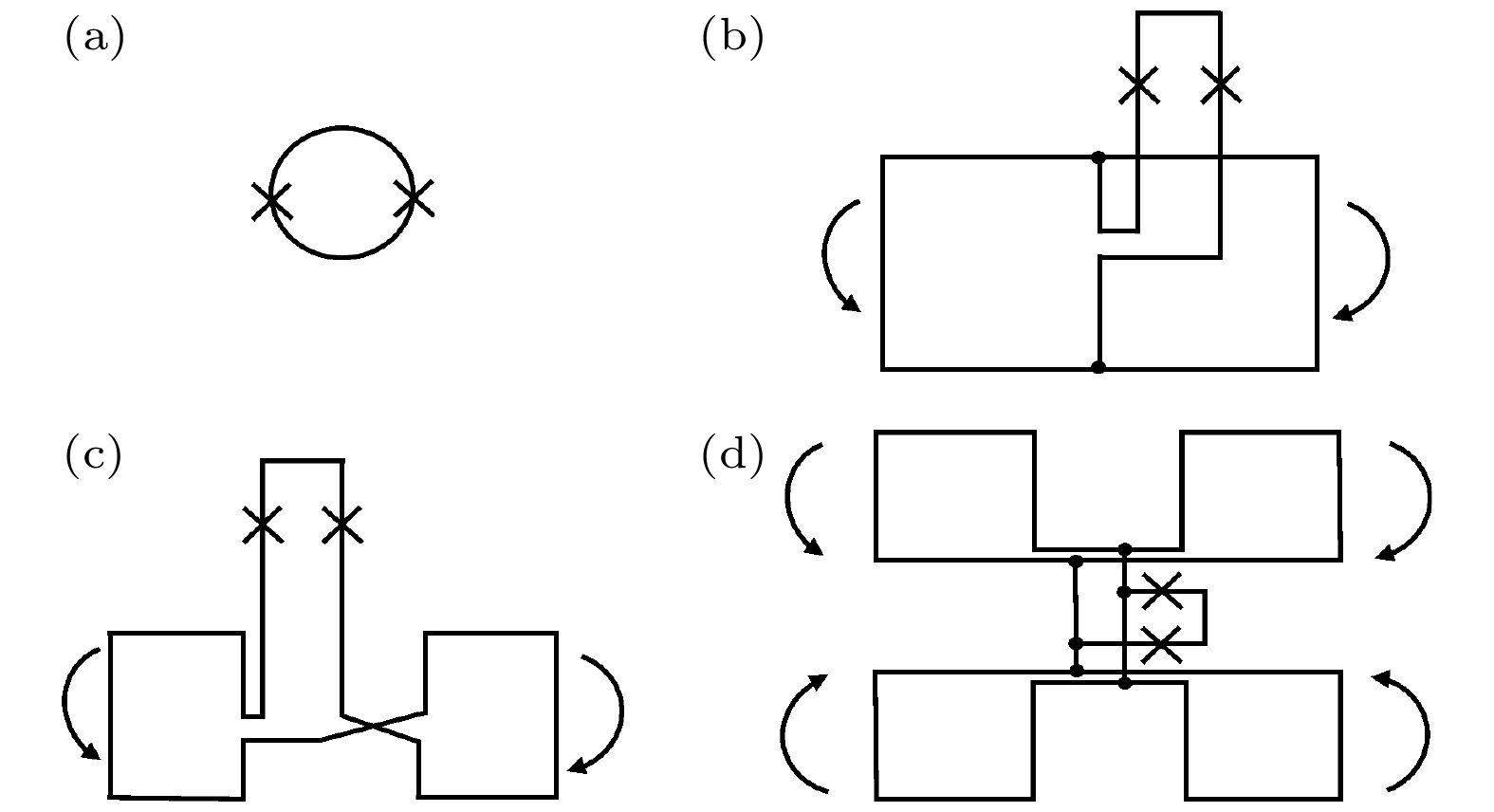 图 1 (a) SQUID环路示意图; (b) 一阶梯度并联SQUID环路结构示意图; (c) 一阶梯度串联SQUID环路结构示意图; (d) 二阶梯度并联SQUID环路结构示意图
图 1 (a) SQUID环路示意图; (b) 一阶梯度并联SQUID环路结构示意图; (c) 一阶梯度串联SQUID环路结构示意图; (d) 二阶梯度并联SQUID环路结构示意图

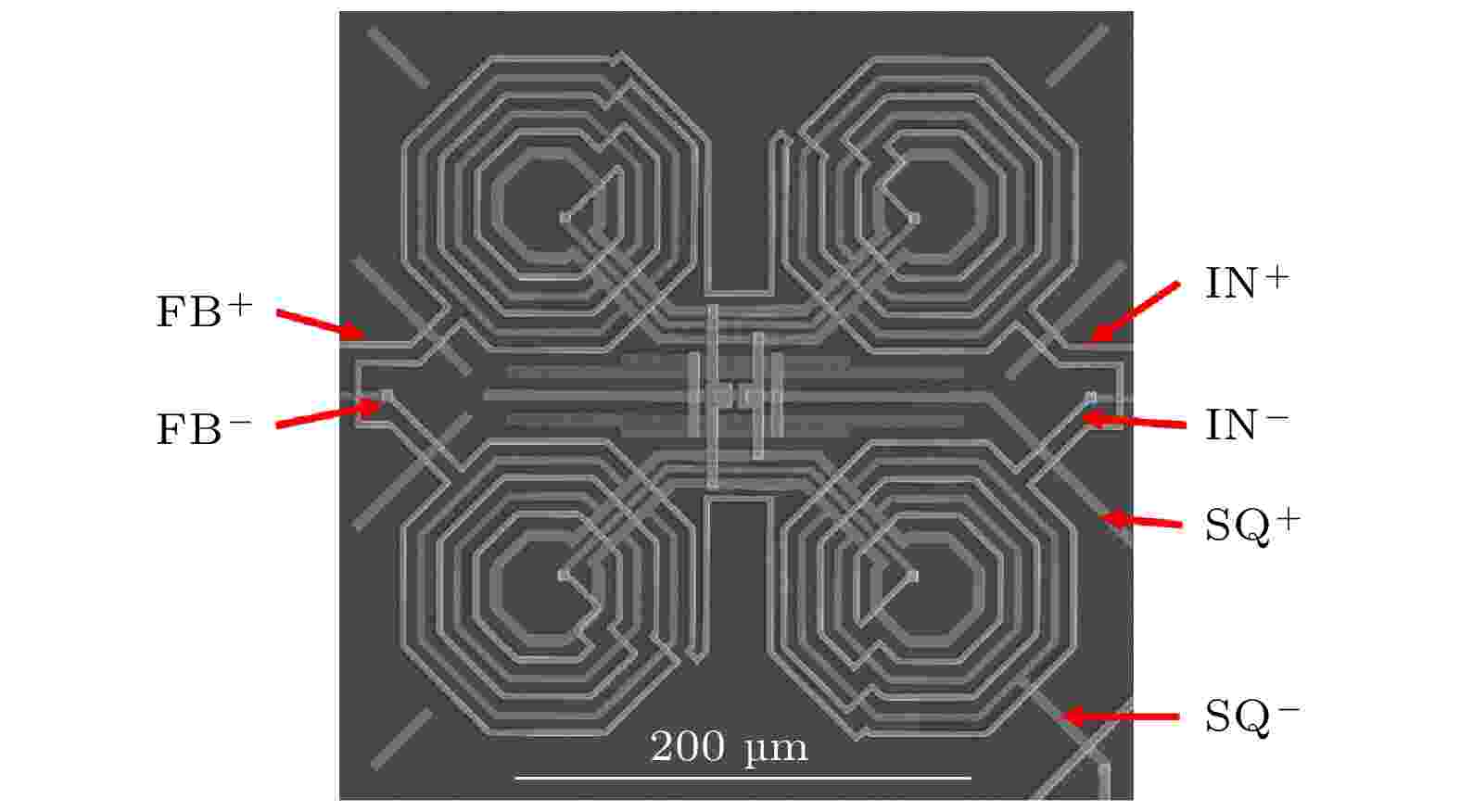 图 2 二阶梯度交叉耦合SQUID电流传感器扫描电子显微镜图
图 2 二阶梯度交叉耦合SQUID电流传感器扫描电子显微镜图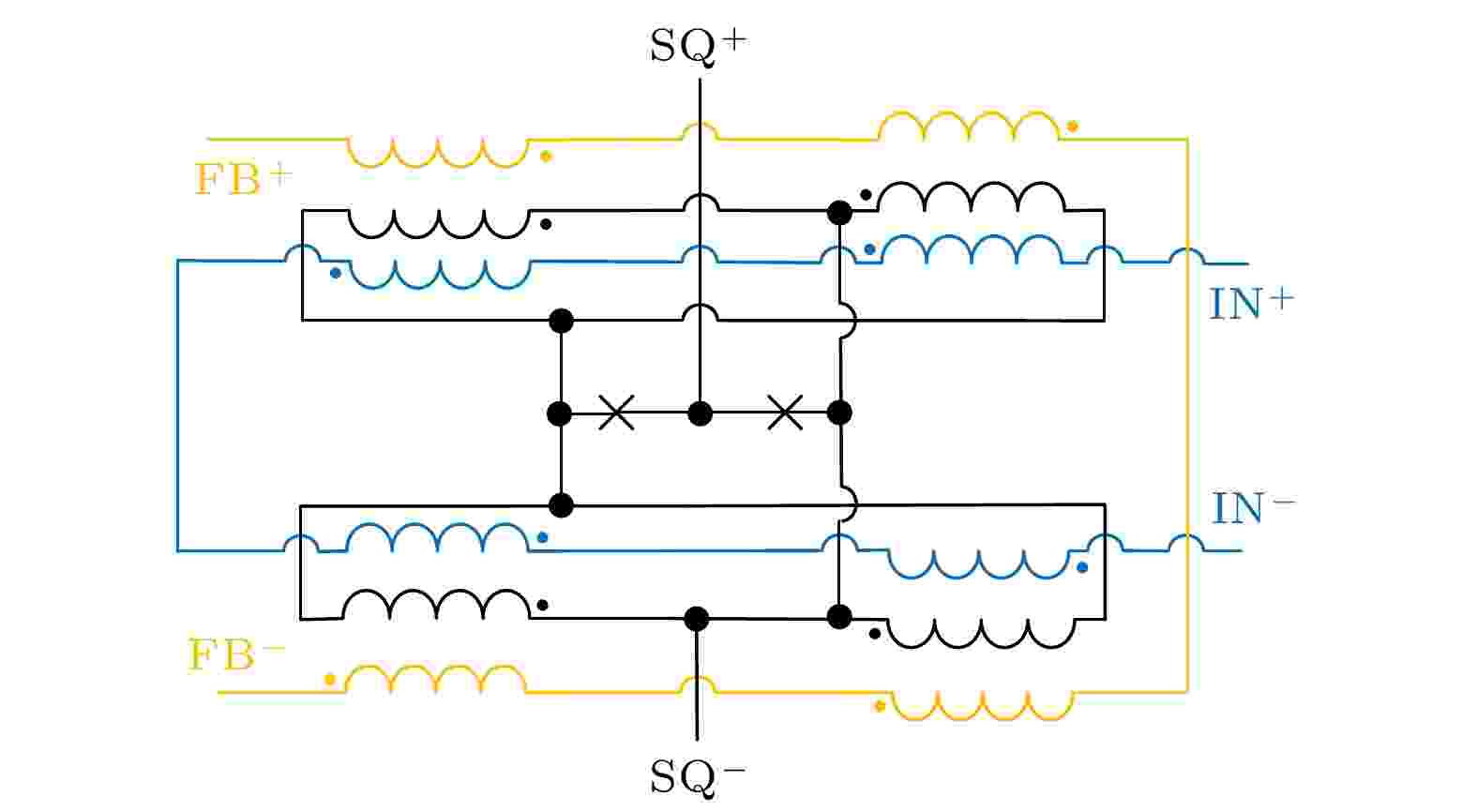 图 3 二阶梯度交叉耦合SQUID电流传感器等效电路图
图 3 二阶梯度交叉耦合SQUID电流传感器等效电路图




 图 4 二阶梯度交叉耦合SQUID电流传感器的电流-电压曲线
图 4 二阶梯度交叉耦合SQUID电流传感器的电流-电压曲线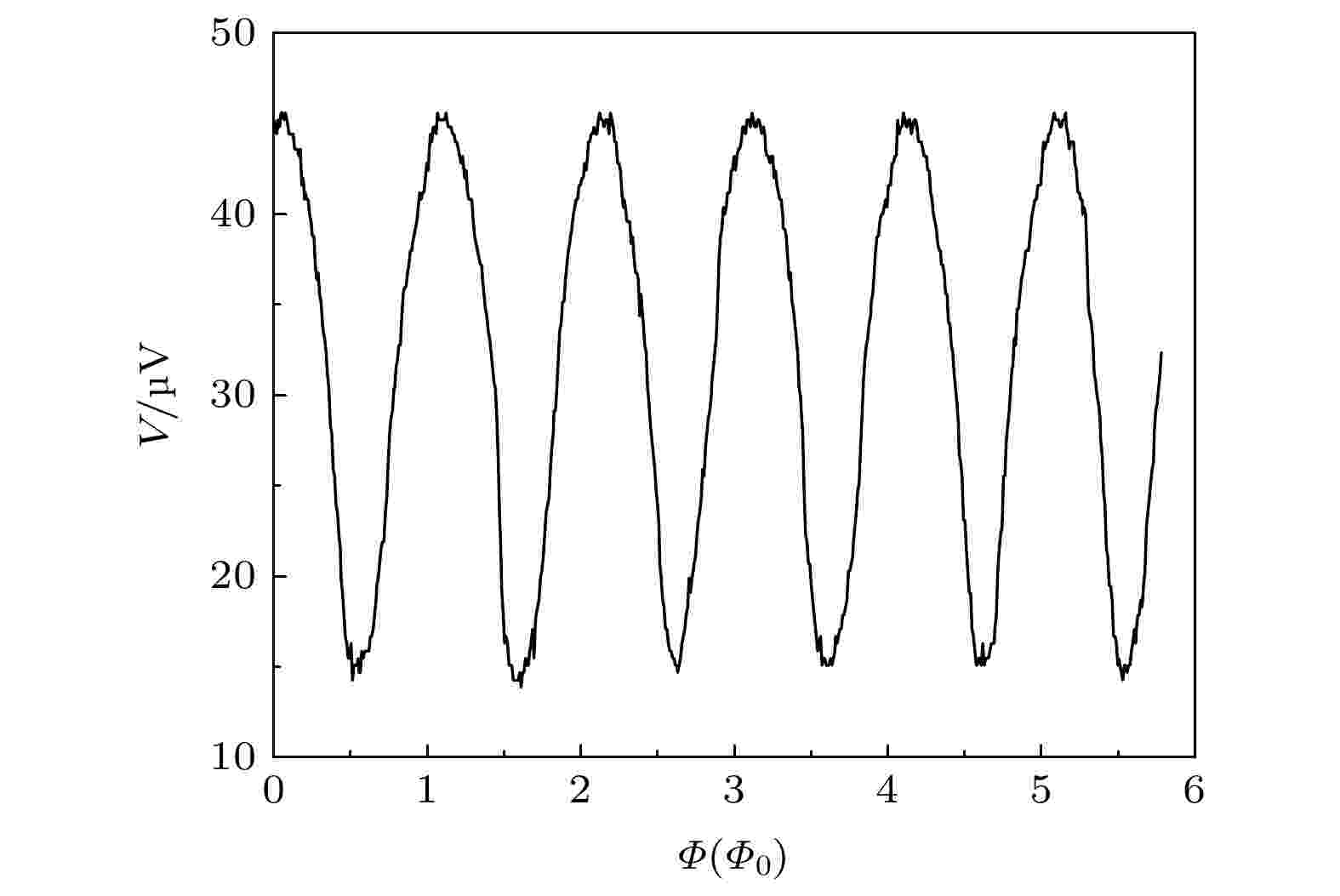 图 5 二阶梯度交叉耦合SQUID输入线圈的电压-磁通调制曲线
图 5 二阶梯度交叉耦合SQUID输入线圈的电压-磁通调制曲线

 图 6 二阶梯度交叉耦合SQUID反馈线圈的电压-磁通调制曲线
图 6 二阶梯度交叉耦合SQUID反馈线圈的电压-磁通调制曲线











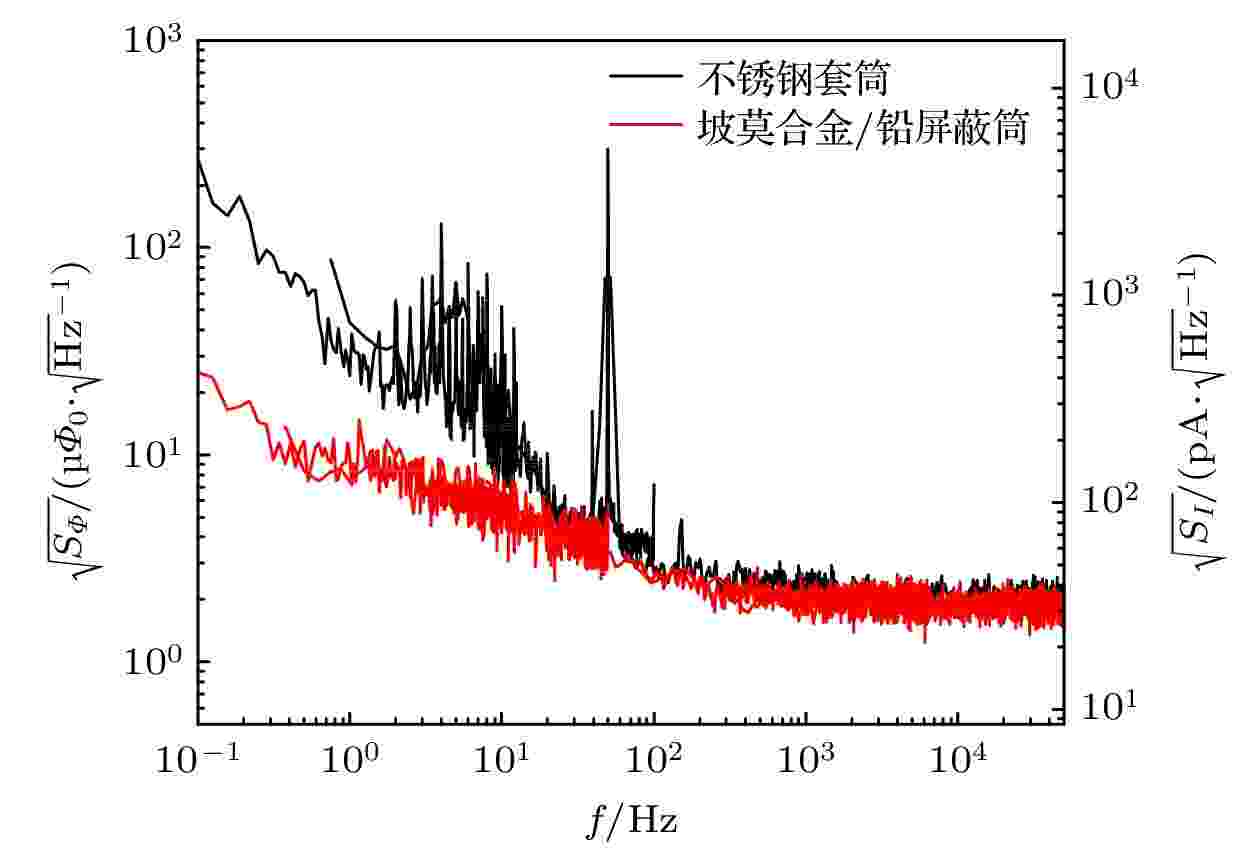 图 7 二阶梯度交叉耦合SQUID电流传感器的噪声曲线
图 7 二阶梯度交叉耦合SQUID电流传感器的噪声曲线






